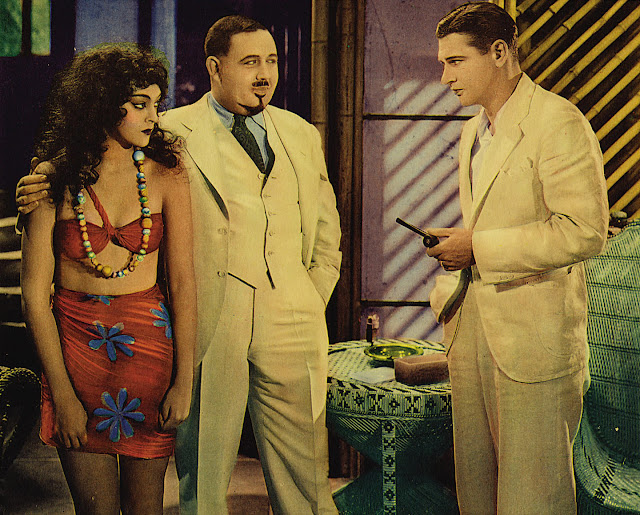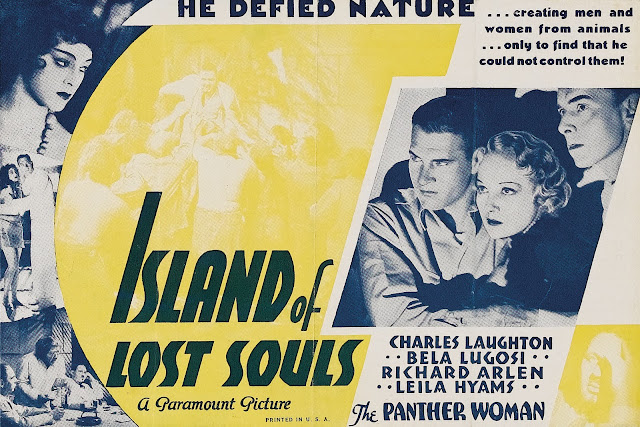RKO's Second Chance 3D Summer
I'd call Second Chance the Last Of The Grey-Suit Mitchums. This was a series peculiar to RKO and characterized by the leading man's wardrobe limitation. Bob wore coat, tie, shirt in these with seldom a style or color variation. His was a rigid fashion choice (chosen for him more accurate). Grey suits seem to have been RKO policy, a dress code strictly applied to male leads. Even when a Victor Mature pinch-hit, things were much the same (size similar VM may in fact have donned the very threads issued to RM). Was inky black-and-white of noir most responsive to said slate of grey? Industry-wide inventory may reveal this shade as by-far most utilized, if not appropriate, to dark storytelling. It's just most noticeable to me in RKO's, from whose Mitchum backlog I'd defy anyone to spot him long, if at all, out of noir's regulation uniform.
 |
| Plain Wrap for RKO Leading Men --- Was This To Keep Us Focused On Their Femme Partners? |
Linda Darnell's similarly limited as to fashion in Second Chance. My accounting revealed but one costume change for her through its 82 minute run-time. Seems weight gain obliged the actress, a freelance as of 1953 and less attentive to diet, to wedge into a distaff- tailored counterpart to Bob's standard issue, the fact of Second Chance being in color impacting not on how either star was turned out. Color is in fact an elastic term here, for there's few uglier or more blotchy hues than what survives of Second Chance, a decent print of which I've never seen, though 3-D revivals elude me so far. Does right/left projection in 35mm bring back Technicolor values surely there when Second Chance played new during summer of 1953?
There was a singular mindset at RKO controls. For all his seeming indifference to what went on there, Howard Hughes did lay personal stamp on what this company shipped, and based on grey suit common threads, I'd say he was most engaged by the Mitchums, perhaps as much so as actress vehicles micro-managed by the tycoon turned mogul. Hughes-maintained noir roads tended to intersect in
 |
| Linda Darnell Ties-In With Leica Cameras for Second Chance Location Publicity |
 |
| Jack Palance, the 50's Most Neurotic Badman, Force Feels Linda Darnell |
3-D was further novelty affixed to Second Chance. First Time! Big Stars in 3-D! cried one-sheets, not very flattering to Vincent Price, but truthful enough for Mitchum being added depth's most bankable participant so far. The process was most effective for a cable car rescue and finale that '53 reviewing found almost unbearable in terms of suspense. Here's where first-run perception parts with two-dimension remnant we settle for ... effect achieved with toys and process screening die hard without 3-D to emphasize heights from which several characters plunge. What looks risibly fake to us was edge-of-seat stuff to those issued stereo specs.
 |
| Robert Mitchum and Linda Darnell Confer with Director Rudolph Maté During Second Chance Filming |
RKO's decision to go 3rd dimensioning came at eleventh hour of late February 1953, smash grosser independent Bwana Devil then filling nostrils of a caught-off-guard industry. Since time was of essence in trading off a gimmick, they'd have cameras rolling within a month, Second Chance to ASAP-open in July. Heat was on for early bookings at theatres 3-D equipped, but RKO got sticker shock over pricing of Second Chance prints. While the dimensional pic in dates so far has proved one of the biggest money-makers on the RKO line-up currently, "Chance" is being played off at a pace slower than usual because of the tricky 3-D economics, said Variety.
RKO made it known they were limiting print orders to 200. Reason for this was expense of left and right components for each Second Chance booking, cost of the pair $1,000, plus another $500 for stereophonic sound wedded to the show. This totals $1,500 for an item which, for a convention black-and-whiter, would cost around $250, pointed out Variety. Getting Second Chance out wide would represent a gamble for distribution, however well it was doing on initial dates. RKO announced they'd go with 2,200 or so 3-D engagements before releasing Second Chance in standard 2-D. Estimates by October 1953 saw a possible $2.5 million in domestic receipts for the Mitchum/Darnell starrer, considered good coin by the trade. By November and waning interest in 3-D, RKO announced it would release Second Chance flat only in England, saving increased tab for a process they felt had maxed out, both here and over there.























































